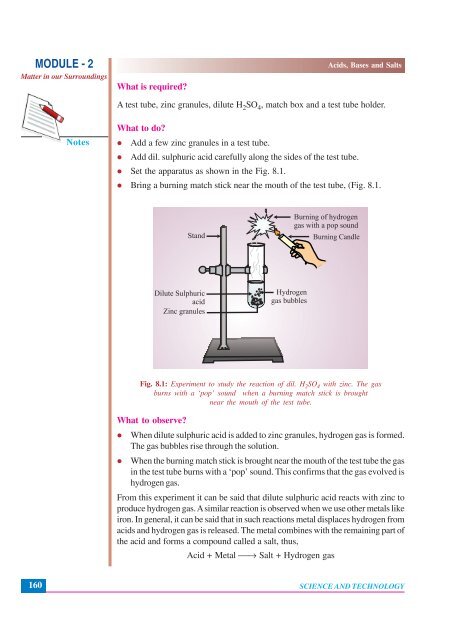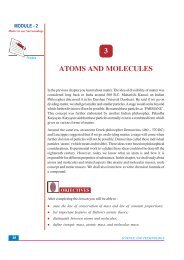8. Acids, Bases and Salts (41.1 MB)
8. Acids, Bases and Salts (41.1 MB)
8. Acids, Bases and Salts (41.1 MB)
You also want an ePaper? Increase the reach of your titles
YUMPU automatically turns print PDFs into web optimized ePapers that Google loves.
MODULE - 2<br />
Matter in our Surroundings<br />
What is required?<br />
<strong>Acids</strong>, <strong>Bases</strong> <strong>and</strong> <strong>Salts</strong><br />
A test tube, zinc granules, dilute H 2 SO 4 , match box <strong>and</strong> a test tube holder.<br />
Notes<br />
What to do?<br />
<br />
<br />
Add a few zinc granules in a test tube.<br />
Add dil. sulphuric acid carefully along the sides of the test tube.<br />
Set the apparatus as shown in the Fig. <strong>8.</strong>1.<br />
Bring a burning match stick near the mouth of the test tube, (Fig. <strong>8.</strong>1.<br />
St<strong>and</strong><br />
Burning of hydrogen<br />
gas with a pop sound<br />
Burning C<strong>and</strong>le<br />
Dilute Sulphuric<br />
acid<br />
Zinc granules<br />
Hydrogen<br />
gas bubbles<br />
Fig. <strong>8.</strong>1: Experiment to study the reaction of dil. H 2 SO 4 with zinc. The gas<br />
burns with a ‘pop’ sound when a burning match stick is brought<br />
near the mouth of the test tube.<br />
What to observe?<br />
When dilute sulphuric acid is added to zinc granules, hydrogen gas is formed.<br />
The gas bubbles rise through the solution.<br />
When the burning match stick is brought near the mouth of the test tube the gas<br />
in the test tube burns with a ‘pop’ sound. This confirms that the gas evolved is<br />
hydrogen gas.<br />
From this experiment it can be said that dilute sulphuric acid reacts with zinc to<br />
produce hydrogen gas. A similar reaction is observed when we use other metals like<br />
iron. In general, it can be said that in such reactions metal displaces hydrogen from<br />
acids <strong>and</strong> hydrogen gas is released. The metal combines with the remaining part of<br />
the acid <strong>and</strong> forms a compound called a salt, thus,<br />
Acid + Metal ⎯→ Salt + Hydrogen gas<br />
160<br />
SCIENCE AND TECHNOLOGY
















